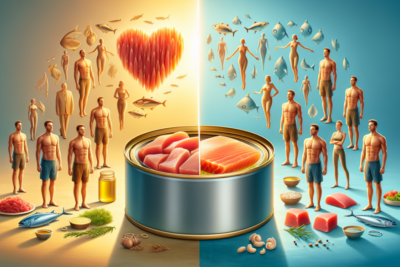
Confusion over ultra-processed food labeling leads many consumers into a grey area, often leaving them uncertain about the choices they make at the grocery store. This confusion stems from a lack of clarity in the definition and classification of what exactly constitutes an ultra-processed food.
🔍 Seeking a breakthrough in Type 2 Diabetes management?
Discover our expert insights and innovative approaches on ‘How to Cure Diabetes’.
Click to transform your health journey today!
What you\'ll find in this article?
- What are ultra-processed foods?
- Should we avoid ultra-processed foods altogether?
- How do ultra-processed foods affect our health?
- What role does socio-economic status play in ultra-processed food purchases?
- How can we navigate the grey area of ultra-processed foods?
- What are consumer attitudes towards ultra-processed foods?
- Exploring the complexities of ultra-processed foods
- Relating issues: Ultra-processed foods and consumer choices
What are ultra-processed foods?
Ultra-processed foods, or UPFs, are food items that have undergone significant industrial processing and often contain ingredients not typically used in home cooking. This can include artificial colors, flavors, preservatives, and sweeteners. UPFs are designed for convenience and palatability, but they often lack nutritional value.
Understanding the impact of ultra-processed foods on health is critical, as these foods are linked to various negative health outcomes. Their prevalence in the modern diet is alarming, with some studies indicating that they make up more than half of the total food intake in certain countries.
Despite their widespread availability, there is a growing debate over whether these foods should be considered a part of a healthy diet. The issue is complex, with consumer awareness of ultra-processed food consumption varying widely.








Explore our specialized services in diabetes care 🌟.
From personalized diet plans to effective exercise routines, we have what you need to take control of Type 2 Diabetes.
Visit our services page now!
Should we avoid ultra-processed foods altogether?
The question of whether to completely avoid UPFs is a contentious one. Some nutritionists argue that in moderation, these foods can have a place in a balanced diet. However, the health risks of ultra-processed foods cannot be ignored.
These foods are often high in sugar, salt, and unhealthy fats, which can contribute to chronic diseases such as obesity and diabetes. The key seems to be in understanding and identifying healthier options within ultra-processed foods.
A shift in consumer preferences for food processing is evident, with a trend towards foods that are less processed and contain more natural ingredients. This reflects a growing desire for healthier eating habits and more transparency in food labeling.
How do ultra-processed foods affect our health?
There is substantial evidence to suggest that a diet high in UPFs can lead to a variety of health issues. Studies have linked these foods to obesity, heart disease, and even mental health problems. The long term effects of ultra-processed foods are a particular concern, as they may contribute to sustained health problems over time.
Despite their convenience, the nutritional compromise that often comes with UPFs is significant. A diet high in these foods can lead to nutrient deficiencies, as they often displace whole foods that are rich in essential vitamins and minerals.
The truth about ultra-processed food labeling systems is that they often fail to provide the clarity needed for consumers to make informed choices. This lack of transparency can inadvertently lead to poorer dietary decisions.
What role does socio-economic status play in ultra-processed food purchases?
- Socio-Economic Status (SES) is a significant factor in UPF consumption. Lower SES households tend to purchase more UPFs, partly due to their affordability and longer shelf life.
- Grocery purchase data reveals that these households often have limited access to fresh, whole foods, making UPFs a more convenient option.
- Policy interventions for healthy eating need to address these SES disparities to ensure that all consumers have access to healthier food choices.
Navigating the grey area of ultra-processed foods requires a multifaceted approach. First and foremost, consumers must be educated about the potential risks of UPFs and how to identify them. This involves understanding food labels and the various terms used to describe food processing.
Identifying healthy options within ultra-processed foods is possible by looking for products with shorter ingredient lists and those that contain whole food ingredients. Additionally, embracing cooking and preparing meals from scratch can reduce reliance on UPFs.
Policy interventions can also play a role by improving the transparency of food labeling and encouraging the production of healthier alternatives. Encouraging food manufacturers to reformulate their products to reduce sugar, salt, and unhealthy fats can also help to make UPFs a less detrimental part of the diet.
What are consumer attitudes towards ultra-processed foods?
Consumer attitudes towards UPFs are evolving. With a growing consciousness about health and wellness, many consumers are seeking to reduce their intake of these foods. However, there is still a significant portion of the population that either does not recognize the health implications or values the convenience of UPFs over their potential health risks.
Transparency in food labeling can influence consumer attitudes by providing clearer information about what is in their food. This, in turn, can empower consumers to make choices that are better aligned with their health goals.
The influence of marketing and the media cannot be underestimated in shaping consumer attitudes. While there is growing skepticism towards UPFs, the appeal of their marketing campaigns can often overshadow the negative health messages.
Exploring the complexities of ultra-processed foods
When considering ultra-processed foods a grey area for consumers, it becomes evident that education, policy, and individual choices play substantial roles. Understanding the nuances of UPF consumption can lead to better health outcomes and more informed consumer behavior.
Relating issues: Ultra-processed foods and consumer choices
What is the problem with ultra-processed foods?
The core issue with ultra-processed foods lies in their association with adverse health outcomes and nutrient deficiencies. The processing methods strip away beneficial components such as fiber, while adding harmful elements like trans fats and artificial additives.
Furthermore, UPFs are engineered to be hyper-palatable, often leading to overconsumption and associated health issues such as obesity and metabolic syndrome. The strong consumer awareness of ultra-processed food consumption is crucial in addressing these problems.
Are ultra-processed foods bad for the environment?
Yes, the production of UPFs often has a larger environmental footprint compared to whole foods. The extensive processing requires more energy and water, and generates more waste.
Additionally, the packaging of UPFs tends to contribute to plastic pollution. Consumer preferences for food processing that lean towards environmental sustainability can help mitigate these impacts.
What are 5 examples of ultra-processed foods?
- Frozen meals and pizzas
- Soft drinks and sweetened beverages
- Snack cakes and pastries
- Processed meats like sausages and hot dogs
- Instant noodles and soups
What are the long term effects of ultra-processed foods?
Long-term consumption of UPFs can lead to persistent health problems. These include increased risks of chronic diseases such as type 2 diabetes, cardiovascular diseases, and some cancers.
Moreover, the dietary patterns established by consuming UPFs can be difficult to change, leading to lasting negative impacts on health. The impact of ultra-processed foods on health must be understood for the sake of long-term well-being.
In conclusion, ultra-processed foods a grey area for consumers requires careful navigation. With increased awareness and better labeling practices, consumers can make more informed choices that lead to healthier lifestyles. While UPFs may not be completely avoidable, understanding their impact and making conscious choices can significantly improve health outcomes.
✨ Other articles you might be interested in:
- Substitute for psyllium husk: top choices and uses
- Will Popcorn Raise My Blood Sugar? Simple Answers for Diabetics
- Can type 2 diabetics safely drink non-alcoholic beer?
- Dietary techniques to manage sugar cravings: What works and what doesn't
- Exploring How Weight Loss Drugs May Also Reduce Cravings for Alcohol



